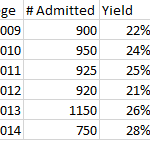If you are a senior in High School, you may think it’s time to sit back, relax (or maybe worry), because you are applications are submitted. You may have heard back from “the one” and know where you are attending College. Or, like, most seniors, you are impatiently waiting for April 1st to come, which is the date many Colleges let you know the answer to a very important question. While I admit you may deserve a break, now is not the time…
You may have submitted your scholarship application for the Colleges where you applied, but there are THOUSANDS of more scholarships out there, waiting for an enterprising Senior to apply to and win. Even if you don’t have the most stellar grades and/or test scores, you may be more qualified than you think. Need some examples?
How about the Gallery Collection’s 9th annual $10,000 Design-a-Greeting-card scholarship?
Or Sub Pop’s Every Loser’s a Winner scholarship – 3 scholarships totaling $15,000?
If that is too mainstream, how about:
Wear Ducktape to Prom Scholarship?
Write a Fire Sprinkler Essay for the The American Fire Safety Association and maybe win $20,000?
There are also some very specialized scholarships for a relatively small group of qualified applicants:
The International Dairy-Deli-Bakery Scholarship for students who work 13 or more hours a week at a member IDDBA.
If you are bored, check out the Chick and Sophie Major Memorial Duck Calling Scholarship Contest on YouTube.
Yes, the possibilities are endless. Are you tall? Member of Clowns of America International? Have you promoted vegetarianism in your school? Think of ANYTHING that makes you unique, and there just might be a scholarship for that. If you are looking for more generic scholarships, alll you have to do is type “college scholarships” to get a long list of available scholarships, some for big money. Check out Scholarships.com, Cappex.com, FastWeb.com, CollegeBoard.org, EducatorLabs.org, etc., etc. Otherwise, type in whatever comes to mind, such as “ketchup loving college scholarship” and see what you find.
Make sure to ask your parents if there are any scholarships available through their work. If they belong to a Union, there is a good chance that the answer is yes. The more people you ask, the more likely you will find out about a scholarship that is not well-publicized, and then your chances of winning go up.
If you are trying to figure out whether this is worth your time, I remind my kids that a single $1,000 scholarship equates to over 100 hours at a minimum wage job.
Want some more advice on financial aid and saving money both before and while you are in College? Check out the Ultimate Saving Guide and Money Management for Students.
An Eligible College Student user recommended this page from Rate.com: Finance Guide for College Students.
Looking for other ways to get money to pay for College? Check out Finding Colleges with Generous Financial and/or Merit Money, Choosing Where to Apply Based on Your Financial Position and What Parents Can Teach Their Kids About Money for more advice.
 Have you found any unique or extraordinary scholarships? Please share them by leaving a post.
Have you found any unique or extraordinary scholarships? Please share them by leaving a post.










